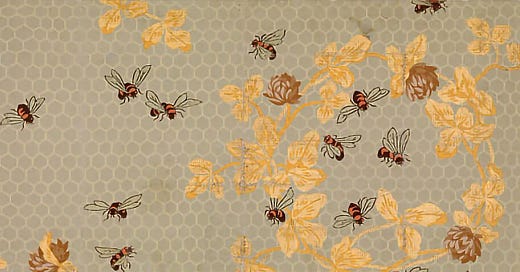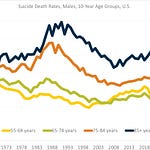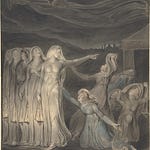I talk about three big inspirations to me: Thomas Day (a North Carolina cabinetmaker, an antebellum free Black man), Candace Wheeler (the “mother” of American interior design — for the masses!), and Julia Child (I hope you already know who she is). There is plenty of beauty to be found in the product of everyday work and living.

Episode Links
Thomas Day
Thomas Day (c. 1801–1861) was an American furniture craftsman and cabinetmaker in Milton, Caswell County, North Carolina.[1] Born into a free African-American family in Dinwiddie County, Virginia, Day moved to Milton in 1817 and became a highly successful businessman, boasting the largest and most productive workshop in the state during the 1850s.[1]: 1, 8, 21, 23 [2][3] Day catered to upper-class white clientele and was respected among his peers for his craftsmanship and work ethic.[1]: 27 [2][4] Day came from a relatively well-off family and was privately educated.[1]: 2, 5, 7 Today, Day's pieces are highly sought after and sell for high prices; his work has been heavily studied and displayed in museums such as the North Carolina Museum of History.[5][6][3][7] Day is celebrated as a highly skilled craftsman and savvy businessman, specifically in regards to the challenges his race posed to his success in the Antebellum South.[7][2]: 35, 58 [6][8]
Smithsonian: Thomas Day: Master Craftsman and Free Man of Color - includes videos and online gallery
Book (which I own): Thomas Day: Master Craftsman and Free Man of Color (Richard Hampton Jenrette Series in Architecture and the Decorative Arts)
Candace Wheeler
Candace Wheeler (née Thurber; March 24, 1827 – August 5, 1923), traditionally credited as the mother of interior design, was one of America's first woman interior and textile designers. She helped open the field of interior design to women, supported craftswomen, and promoted American design reform. A committed feminist, she intentionally employed women and encouraged their education, especially in the fine and applied arts, and fostered home industries for rural women. She also did editorial work and wrote several books and many articles, encompassing fiction, semi-fiction and non-fiction, for adults and children. She used her exceptional organizational skills to co-found both the Society of Decorative Art in New York City (1877) and the New York Exchange for Women's Work (1878); and she partnered with Louis Comfort Tiffany and others in designing interiors, specializing in textiles (1879-1883), then founded her own firm, The Associated Artists (1883-1907).[1][2][3][4]
….
Society of Decorative Art in New York
[edit]
Wheeler co-founded the Society of Decorative Art with Caroline E. Lamson (Mrs. David) Lane in New York in 1877.[30][31] She hired the recently widowed Elizabeth Bacon (Mrs. General George Armstrong) Custer as secretary: the two women became fast, life-long friends.[2][5][32] The Society was intended to help women support themselves through artistic handicrafts including needlework and other decorative arts. It served the thousands of women who were left indigent at the end of the Civil War. Wheeler called on prominent New York society matrons to support a shop in which the high-quality, custom-made goods could be sold to produce income; they had five hundred subscribers within three years.[30][32][23]
Leading artists were hired to teach or judge exhibits at the Society in New York, including Louis Comfort Tiffany and John LaFarge. Wheeler helped to start branches in Chicago, St. Louis, Hartford, Detroit, Troy, New York and Charleston, South Carolina.[29][33] Although she described resigning in a huff from the Society of Decorative Arts in 1879, she actually remained involved and supportive for the next several years.[34]
New York Exchange for Women's Work
In 1878 Wheeler helped launch the New York Exchange for Women's Work, where women could sell any product that they could manufacture at home, including baked goods and household linens.[30][34] To serve a broader range of women, no artistic ability was required. The Exchange opened in March 1878 with a consignment sale of thirty items at the home of Exchange co-founder Mary Atwater (Mrs. William) Choate. In April, the Exchange moved to a rented facility and by May it was successful enough to employ two part-time sales women. In its first year, it paid out nearly $14,000 in commissions. By 1891, there were at least 72 Exchanges across the United States.[32] The New York Exchange continued to operate until 2003.[35]
The Panic of 1873: Library of Congress
The Panic of 1873 triggered the first 'Great Depression' in the United States and abroad. Lasting from September 1873 until 1878/9, the economic downturn then became known as the Long Depression after the stock market crash of 1929. Currency in the nineteenth century was based on specie. Metal money circulated, and banks issued paper banknotes backed by the supply of gold and silver. In the United States, this system began breaking down in the face of financing the Civil War. President Lincoln authorized the printing of paper money, called "Greenbacks," to pay ballooning expenses. Widespread use of fiat External money continued into the Reconstruction Era, fueling the rapid expansion of railroads and wild speculation.
Banks, especially Jay Cooke and Co. raised millions of dollars through selling bonds to finance construction. Speculators 'bet' on the railroad, gambling on the fact that settlement and opportunities to make money would follow behind the completed railway. However, construction expenses ballooned and outpaced financing. Efforts to raise more funding failed. When they could no longer pay the bills, Jay Cooke and Co. and other banking houses folded. The collapse of the railway financiers sparked high bank withdrawals, the failure of brokerage firms, and railway construction halted. By September 20th, the New York Stock Exchange suspended trading for the first time.
Prior podcast mentioning Wheeler: Failure, Sunk Costs, and Candace Wheeler, June 2023
Julia Child
July 2022: Training Lessons from the French Chef: Being Resourceful and Making Mistakes
Julia Child on PBS YouTube Channel - the French Chef also available at Pluto TV currently
UPDATE: Prior post mentioning Julia Child: Oct 2022 - Geeking Out: Chatting with a Fellow Actuary about Writing - I often write (for free) for actuarial publications, and I like to push what I can get away with. (I’ve been inserting sumo references lately… and I’ve got an extended sumo metaphor I would love to try out in my next piece….)















Share this post